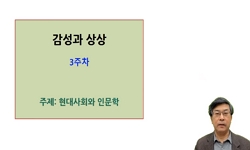The purpose of this study is analyze the variation of literary Imagination in Yury Olesha's <The Cherry Stone>. This work obviously occupies a special place in his oeuvre. It marks his definitive transition from fiction to artistic autobiography...
http://chineseinput.net/에서 pinyin(병음)방식으로 중국어를 변환할 수 있습니다.
변환된 중국어를 복사하여 사용하시면 됩니다.
- 中文 을 입력하시려면 zhongwen을 입력하시고 space를누르시면됩니다.
- 北京 을 입력하시려면 beijing을 입력하시고 space를 누르시면 됩니다.
닫힌 시대 공간 속의 문학 상상력의 한 변주 : Yu. 올레샤의『버찌씨』연구 = A Study on the Variation of Literary Imagination in Yury Olesha's <The Cherry Stone>
한글로보기부가정보
다국어 초록 (Multilingual Abstract)
In this work Olesha creates and especially sharp juxtaposition between the unseen world of Imagination with its solipsistically determined rules and the seen world of Soviet socialism. The hero-narrator Fedia is the loser in lover's triangle. Because of unrequired love he cannot adapt himself to real world, and therefore retreats from here to the world of imagination. In compensation for the failure of his love he lives in the world of imagination and dreams the metamorphosis in real world. But all his efforts are doomed to end in failure. Because his literary imagination establishes the metaphors and similes which is almost always based on resemblances of apparent form and his invisible land is only the impressionistic artistic vision of light and colour. And his metamorphosis turne out self-deception which is irresponsible for his own existence. But above all, the more important cause of his failure is a change of the times.
In <The Cherry Stone> the real gardener is Avel. He is fully integrated into Soviet society, and therefore can blend his own power of imagination into the first five-years plan. He is a willing member of the group, which gives him the power to design and execute plans on a massive scale.
In the thirties Olesha's works have become trivial and his themes of observation and imagination were unnecessary. The new themes as industrialization, collectivization and the great construction plan replaced those. Olesha was capable of discerning details of his surroundings, but could not see the larger picture of change of soviet society. Although he integrated poetic "invisible land" into the new socialistic utilitarian reality, the prospect of his optimistic conclusion is still doubt. In Thirties the third way in which Olesha wish to mingle fact with fantasy increasingly disappeared.
The purpose of this study is analyze the variation of literary Imagination in Yury Olesha's <The Cherry Stone>. This work obviously occupies a special place in his oeuvre. It marks his definitive transition from fiction to artistic autobiography. In 1929, when Olesha wrote <The Cherry Stone>, the first five-year plan began in Soviet society. The Soviet authorities began to demand more the utilitarianism from Soviet writers. <The Cherry Stone> was the answer to this requirement and a product of Olesha's artistic compromise between Old World and New World.
In this work Olesha creates and especially sharp juxtaposition between the unseen world of Imagination with its solipsistically determined rules and the seen world of Soviet socialism. The hero-narrator Fedia is the loser in lover's triangle. Because of unrequired love he cannot adapt himself to real world, and therefore retreats from here to the world of imagination. In compensation for the failure of his love he lives in the world of imagination and dreams the metamorphosis in real world. But all his efforts are doomed to end in failure. Because his literary imagination establishes the metaphors and similes which is almost always based on resemblances of apparent form and his invisible land is only the impressionistic artistic vision of light and colour. And his metamorphosis turne out self-deception which is irresponsible for his own existence. But above all, the more important cause of his failure is a change of the times.
In <The Cherry Stone> the real gardener is Avel. He is fully integrated into Soviet society, and therefore can blend his own power of imagination into the first five-years plan. He is a willing member of the group, which gives him the power to design and execute plans on a massive scale.
In the thirties Olesha's works have become trivial and his themes of observation and imagination were unnecessary. The new themes as industrialization, collectivization and the great construction plan replaced those. Olesha was capable of discerning details of his surroundings, but could not see the larger picture of change of soviet society. Although he integrated poetic "invisible land" into the new socialistic utilitarian reality, the prospect of his optimistic conclusion is still doubt. In Thirties the third way in which Olesha wish to mingle fact with fantasy increasingly disappeared.
목차 (Table of Contents)
- Ⅰ. 들어가는 말
- Ⅱ. 보이지 않는 세계 - 상상의 공간으로의 도피
- Ⅲ. 변신 - 상처받은 자아의 거짓 보상
- Ⅳ. “보이지 않는 나라로의 여행” - 자기기만의 상상력
- Ⅴ. 나오는 말
- Ⅰ. 들어가는 말
- Ⅱ. 보이지 않는 세계 - 상상의 공간으로의 도피
- Ⅲ. 변신 - 상처받은 자아의 거짓 보상
- Ⅳ. “보이지 않는 나라로의 여행” - 자기기만의 상상력
- Ⅴ. 나오는 말
동일학술지(권/호) 다른 논문
-
- 淸州大學校 學術硏究所
- 柳在馨
- 2006
-
- 淸州大學校 學術硏究所
- 金憲?
- 2006
-
- 淸州大學校 學術硏究所
- 金憲?
- 2006
-
- 淸州大學校 學術硏究所
- 郭東哲
- 2006




 RISS
RISS







